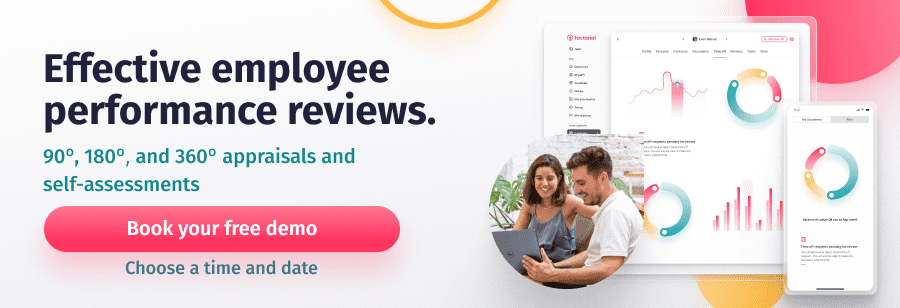The 360 feedback system has the potential to benefit all kinds of businesses. 360 feedback reviews, also known as multi-rater reviews, help employees understand their personal strengths and weaknesses.
This method of evaluation is used to guide employees towards constant improvement and professional development. HR teams worldwide are adopting this review process as an effective assessment technique. But of course, like any evaluation method, there are benefits and limitations.
In this article, we will define what 360 feedback is, its purpose and its impact on employee performance.
What is 360 Feedback?
Typically, this type of performance appraisal is measured and delivered using around 7-12 raters, whose responses are kept anonymous. These multi-raters may be all or a selection of the following people:
- The employees’ supervisors
- Employees peers
- Internal reports
- External raters, such as clients or vendors
Those who are chosen to participate work directly with the employee in question, whether that’s internally or externally. The method is called a 360 performance review as the feedback is gathered from all angles of the company, rather than just one individual opinion.

What is the purpose of 360 feedback?
Ultimately, these evaluation methods help employees to understand how their fellow employees or customers view them on a professional level. This is not limited to their work quality. They also used to evaluate how they are perceived by their coworkers, and how their performance affects others.
These appraisals usually focus on the following skills:
- Leadership
- Teamwork
- Communication
- Management
- Company Alignment
Eventually, this feedback can be used to form a development plan for the individual.
How to Gather 360 Review Feedback?
When conducting 360-degree evaluations, the feedback is collected in the form of reviews, evaluating the competencies of the employee.
An effective way to gather these evaluations is to use a performance review tool. These tools are extremely dynamic and enable you to digitally assess the employees’ scores. These tools often use closed questions, with a specific answer range such as yes and no questions or a rating scale of 1-10 etc. By using closed questions, you can easily gather quantitative results and make clear comparisons.
Alternatively, you can use open-ended questions. This gives the employee a deeper understanding of the results they have received from each individual.
What are the Benefits of 360-degree Feedback?
As well as providing employees with a broader, more accurate overview of their performance, there are several other benefits:
- Involves multiple raters: A variety of people are asked to contribute to the review, therefore the feedback provided is more valid and objective.
- Improves communication: Communication increases between the team because the subject understands how others perceive them which in turn assists with teamwork.
- Encourages personal development: This type of assessment gives the employee an overview of how they see themselves and how others see them too.
- Increases employee motivation: Receiving feedback from a number of people (who may share some similarities) gives the subject the motivation to improve.
- Reinforces core competencies: When giving feedback the respondents are reminded about the fundamental competencies of the company.
- Addresses personality and behaviour: It gives the employee an understanding of how their behaviour affects themselves and the people around them.
- Promotes career development: This feedback model helps to improve career development planning and guides employees through this process.

How to Deliver 360 Feedback Results
When delivering 360 feedback, the goal should be to provide constructive feedback to the employee. Therefore, you should focus on the key points and avoid information overload. Remember, this should not be a negative experience for the employee, it should be viewed as a source for professional development.
Try to provide actionable feedback by focusing on the strengths of the employee and then the career progression plan going forward. This helps employees remember the goal of the feedback. Lastly, when presenting this feedback, you should keep the focus on the future. Next, you can start forming an action plan or development plan with the subject.
How to Create a Development Plan:
Your professional development plan strategies define how your employee will achieve their goals in the future. The best technique is to organise them into small stepping stones, that are ordered by level of priority. This helps the subject to clearly visualise their goals and objectives.
Here are a few tips to help you write a professional development plan:
- Make the goals specific and actionable
- Make sure they are aware of any available resources, eg. training, coaching and mentoring.
- Set clear measurable milestones
How often should you conduct 360 reviews?
Stay consistent with your employees, by conducting 360 evaluations on a regular basis. You may choose to conduct these annually or quarterly. Conducting 360 reviews on a regular basis helps you to ensure that your employees are working towards their performance goals. Ultimately, this enables you to provide any support if needed.
Furthermore, we recommend enforcing a feedback culture so that your employees are used to giving and receiving constructive feedback. This also helps to improve the communication between your employees from all levels of the business.
Related video: What is a Performance Improvement Plan? In this video, we explain the ins and outs of creating a PIP that will encourage your employees to succeed.



